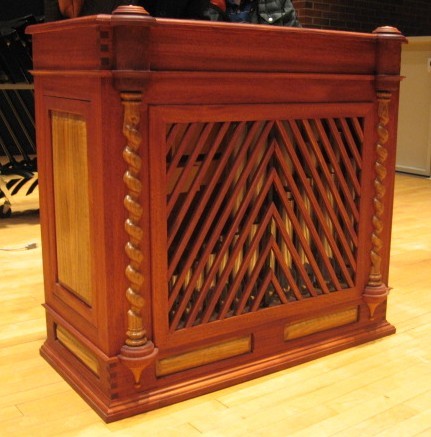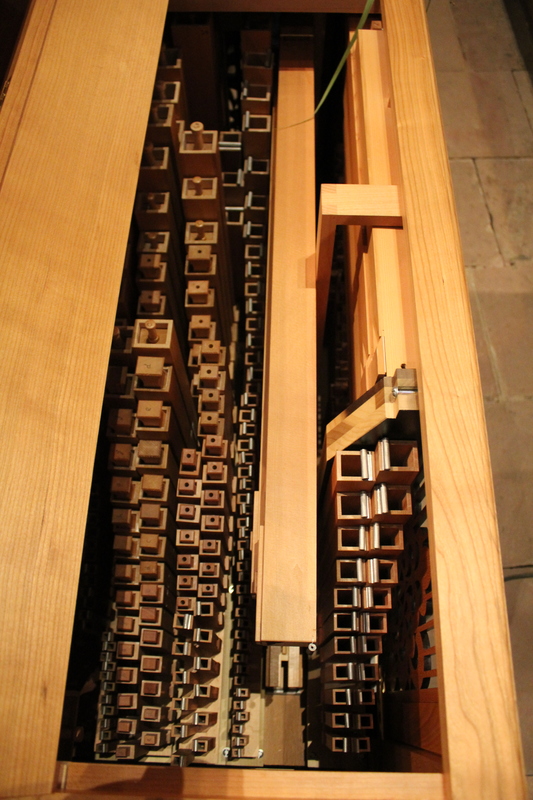From organo di legno to “early music organ”
Despite the imperfections of its model and craftsmanship, the Mertin organ provides a striking alternative to the organs that have been typically used performances of L’Orfeo since the 1960s. Most often, these are very small, compact organs powered by electricity. They are usually referred to as “continuo organs” or “chamber organs,” though these labels can result in confusion since they also refer to different types of small to mid-size organs. A more accurate name for the instrument might be the “early music organ,” since it was developed by instrument makers in the 1960s in response to demand for a transportable organ from a burgeoning community of early music ensembles playing on period instruments. An image is included here of an early music organ by the Dutch firm Klop, one of the best known makers of the instrument.
The early music organ differs in significant ways from the organo di legno. Like the organo di legno, the foundational rank of the early music organ is generally (though not always) made up of wooden pipes. But unlike the organo di legno, in which all ranks of pipes are made of wood, the upper ranks of an early music organ are often made of metal. And even the foundational wooden pipes of the early music organ differ dramatically from those of the organo di legno.
Like the organo di legno, their foundational (eight-foot) rank is usually made of wood; however, the structure of the pipe differs dramatically. Rather than the rich, full-throated sound of the open pipes of the Principale of the organo di legno, the 8’ rank of these compact continuo organs are stopped, reducing the length of the pipe by half. This type of pipe is called a gedackt (after the Middle High German term meaning “covered”) and, outside of early modern Italy, it is ubiquitous in organ building, from the sixteenth century to the present, throughout the globe. The timbre of these stopped pipes is ghost-like, with a strong, penetrating fundamental tone, but with few overtones. Since the early music organ serves as a foundation for voices and other instruments, its timbre impacts the entire ensemble. The hollow, bass-heavy sound of the early music organ is quite distinct from the voices and instruments that it typically accompanies, including all manner of stringed and wind instruments.
The early music organ was designed to serve an early music community whose repertoire, in the 1960s through to the 1980s, revolved around the music of Johann Sebastian Bach. Within this context, the use of a gedackt for the organ’s foundation made sense, as this category of sonority was known to Bach, who even preferred it for continuo playing. Thus, the gedackt satisfied the desire of early music specialists who sought out “authentic” timbres – at least within the realm of German Baroque music.
However, the early music organ has come to serve performances not only of German Baroque repertoire but of all varieties of music from the late Renaissance through to the Classical period. This includes early Italian operas and, more generally, Italian music from the sixteenth and seventeenth centuries. Yet the gedackt, which defines the sound of the early music organ, was not typically used in Italian organ building until the late eighteenth century. One Italian organ builder, Antonio Barcotto, writing in 1652 warned that stopped pipes emitted tones that are “artificial, not natural, as in open pipes.”[2] For an artistic movement that aims to bring historically plausible performance practices and timbres to modern audiences, the early music organ represents a curious blindspot.
[2] “…se bene una canna coconada formerà voce bassa, come se fosse tutta aperta, è da sapere, che tal voce è artificiosa, e non naturale, come quella delle Canne aperte.” Barcotto, Chapter 8. English translation from Peter V. Picerno, “Antonio Barcotto’s Regola e breve raccordo: A Translation and Commentary,” Organ Yearbook 16 (1985): 47-70 at 61.
Citation: Leon Chisholm, ‘The organo di legno’s timbral timber’, in: Materiality of Musical Instruments. A Virtual Exhibition.


